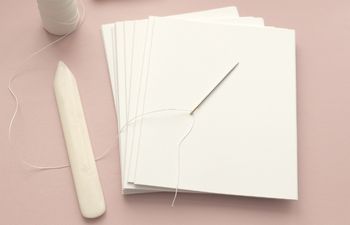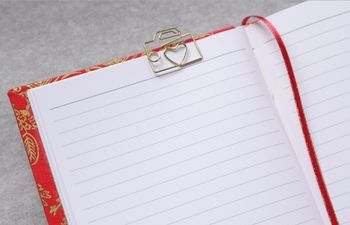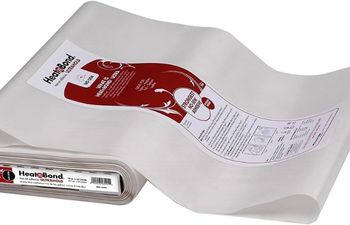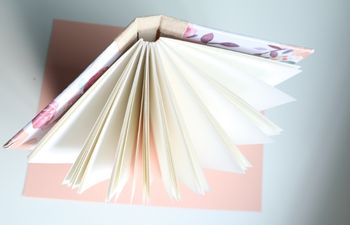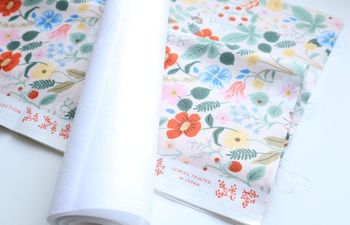I’m often asked about the materials, supplies, tools & equipment I choose for book making, so I’m kicking off a new spotlight series that will reveal what I use in my bindery and why. I know this information will help newer binders follow along with my tutorials and make quicker decisions about what to buy when the time comes to stock up, so I’m excited to get started.
Today’s first post will focus on the #1 question I get asked, “What bookbinding paper do you use and why?”
The early days
My first book was full of 90lb sketch paper. In all honesty, it was the only paper I could afford at the craft store and I truly felt thicker paper = higher quality. This is the case for many newer bookbinders and it’s not a bad thing. Heavyweight paper is harder to damage, so it holds up nicely when learning to use an awl and needle.
Paper features that actually matter
As my binding skills matured, I started to understand that weight is one of many things to consider when buying paper. These other features are equally important:
- Type (text/writing, drawing, watercolor, etc.)
- Grain direction
- Finish
- Texture
- Color
- Digital compatibility
I once made the mistake of using sketch paper in a journal for one of my good friends. A few weeks after giving her the book, I asked for feedback. To my surprise, her response had nothing to do with the things that I thought mattered (the size, how it looked, whether or not it laid flat). Instead, she told me the paper was too hard to work with. Sketch paper has a higher gs/m and slightly textured surface, making it difficult for her ball point pen to glide across the surface. After fifteen minutes of writing, she had to stop and give her hand a rest. Eventually, she gave up.
As you can see, the type, finish and texture are truly important when selecting bookbinding paper. But let’s not forget about grain direction, color and digital compatibility.
Grain direction & color
Once I’d mastered some of the foundational book making techniques, I started focusing on design. This is where a bookbinder moves away from the engineering principles and into the artistic. I played with book sizes, coverings, and paper with lines and grids. I suddenly had to focus on paper size with regard to grain direction (not an easy task) as well as paper colors to compliment some of the pricey coverings I’d bought.
Digital compatibility
In the last few years, I’ve started making journals with lined paper. I learned very quickly that foldable lined paper is not commercially produced, which means I have to print it myself. To do this, I needed to create my own templates and find inkjet compatible paper in the right type, weight, color, size and grain direction. It felt like madness, because it was!
My preferred paper
As a small bindery, I’m unable to buy a bunch of one-off paper reams to satisfy every whim. Instead, I have to choose paper that meets all of my functional needs first (size, grain direction, digital compatibility) while leaving room for beautiful design.
It took me some time to figure out the economics, but I eventually landed on two types of paper that work for 80% of the books I create:
- PC 100 Environment white 12×18 long grain paper by Neenah (80lb text)
This paper is 100% recycled, environmentally-friendly and compatible with nearly all printers. It’s perfect for journals with printed paper (lines, grids, dots). I use this for many different types of journals.
If you’d like to print some yourself, feel free to download my personal lined paper template. - Via Smooth pure white 11×17 long grain paper by Mohawk Fine Papers (70lb text)
This is the BEST all-around paper. It’s digitally compatible, the perfect weight and very affordable in a ream of 500 sheets. I use this for nearly all of my books, especially when I’m experimenting with a new binding.

Resources
Here is a compilation of some of the links above + others that may help in your journey to finding the perfect bookbinding paper!
Where to buy
I personally buy my paper from ThePaperMillStore once or twice per year, but you can pick these up wherever Neenah and Mohawk Fine Papers are sold. I’ve noticed a bit of price gouging on Amazon, so use caution there.
Learn more about paper
- Lined Paper Templates Pack for Bookbinding
- How to Make a Lined Paper Template for Bookbinding
- How to Find Lined Paper for Bookbinding
- Know the Difference | Text and Writing Weight Papers
I hope this spotlight was helpful – please come find me on Instagram and let me know!
ALL my best,
Misty
